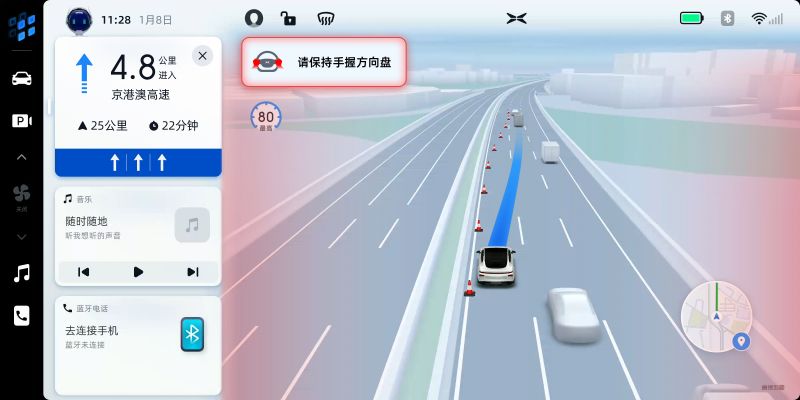China's Tesla Challenger Xpeng Says Drivers Traveled Over 1 Million Kilometers in 25 Days Using its New Autonomous Driving Features
【Summary】Chinese electric vehicle startup Xpeng Inc. announced on Monday that drivers traveled a cumulative distance of 1,023,884 kilometers (636,212 miles) since the company released its latest autonomous driving feature called Navigation Guided Pilot (NGP) on Jan 26. NGP is similar to Tesla's Full-Self Driving feature.

Chinese electric vehicle startup Xpeng Inc. recently rolled out its latest autonomous driving feature called Navigation Guided Pilot (NGP) for drivers in China and its being widely used by drivers just 25 days of being released.
Xpeng reported on Monday that drivers that traveled a cumulative distance of 1,023,884 kilometers (636,212 miles) since the latest software was released on Jan 26, which indicates that the new NGP automated driving features are popular with Xpeng owners.
The cumulative distance traveled by drivers with NGP activated reached 500,000 km within 14 days, and the second 500,000 km 11 days after, Xpeng said.
The NGP function requires XPeng's latest autonomous driving system XPILOT 3.0, which is offered in the company's fully-electric P7 Smart Sedan. The P7 launched in April 2020.
The NGP automated highway driving feature allows drivers to simply enter a destination and the company's P7 sedan will navigate to it without human intervention in most cases. Xpeng considers its to be a SAE level-3 autonomous driving system.
The function is available on Chinese highways which are covered by high-precision maps from Chinese navigation company AutoNavi.
Xpeng's NGP is highly advanced and specifically designed for China's complex and crowded road conditions and driving style. The smart system will follow the route guidance while executing and selecting the optimal route in real-time as well as perform autonomous lane changes.
Xpeng's automated driving system can also automatically identify and avoid traffic cones, warn the driver of upcoming construction sites or toll booths, navigate in stop-and-go traffic, avoid disabled vehicles and large trucks, and warn drivers of when to resume manual control of the vehicle in certain situations, such as in adverse weather.
NPG offers a higher lane change success rate Xpeng said, as well as a low driver intervention requirement than similar systems found in other models on the market in China, the company claims.
During the 25 days from January 26 to February 20, Xpeng said its automatic lane changing and overtaking features were used 131,484 times, and automatic highway ramp entering and exiting were conducted 105,943 times.

Xpeng's Navigation Guided Pilot is available on the company's flagship P7 electric sedan.
Xpeng as a company has invested heavily in autonomous driving. Roughly half of the company's employees work in R&D of new technology for the automaker. Many of these employees work solely on autonomous driving.
Xpeng's P7 is a strong rival to Tesla's flagship Model S in China. Deliveries to customers in China began last June. The P7 was also named as the longest range EV sold in China with an NEDC range of 706km (438 miles).
The electric sedan offers the same level of technology for around half the price of the Model S. Xpeng claims its the most powerful production vehicle in China and comes packed with hardware for automated driving.
The P7 is China's only mass production car with 360-degree dual camera and a radar fusion perception system for added safety. The electric sedan is also outfitted with 14 cameras, 5 millimeter-wave radars, 12 ultrasonic sensors, lidar, centimeter-level high-definition GPS positioning, decimeter-level high-definition mapping.
In total, the P7 sedan uses 31 sensors for autonomous driving functions.
Xpeng is the first automaker to add lidar sensors to its vehicle during production. The lidar will significantly improve the vehicle's high-precision object recognition performance,the company said.
Xpeng's NGP was launched via an OTA (over-the-air) upgrade for P7 customers in China. The OTA updates allow the automaker to keep its vehicle always up to date with the latest software.
-

Electric Nissan Juke: A Sneak Peek at the Future
-

Electric cars set to become more affordable
-

Major creditor in talks to acquire Volta Trucks
-

Chinese EV maker's valuation close to Tesla
-

EVs' Limited Success in the U.S., Excluding Teslas
-

Toyota's Dedication to Quality Shines in Century Bolt Tightening Process
-

Tragic Accident: Bentley's Speed Questioned in Niagara Falls Deaths
-

Accelerating Car Development with Mazda-backed AI Firm
- Toyota to Collaborate With Texas-based Utility Provider Oncor to Accelerate a Vehicle-to-Grid EV Charging Ecosystem
- High Gas Prices Aren’t Enough to Sway Consumers to EVs, Autolist Survey Finds
- Tesla Shutters its San Mateo, CA Office, Lays Off Roughly 200 Autopilot Staff Without Notice
- Hyundai Unveils the IONIQ 6 ‘Electric Streamliner’, its Bold Sedan With a 380-Mile Range and 18-Minute Charging Time
- Volkswagen’s Software Company CARIAD to Use BlackBerry QNX to Support ADAS and Autonomous Driving Functions of Future VW Vehicles
- NHTSA Upgrades Tesla's Autopilot Investigation to 'Engineering Analysis'
- Audi Hits EV Startup NIO With a Trademark Lawsuit Over its Vehicle Naming
- Ford is Investing $3.7 Billion and Adding Over 6,200 UAW Manufacturing Jobs in the Midwest to Produce New Vehicles
- Solid State Battery Startup Solid Power Completes its EV Cell Pilot Production Line
- Mazda Outlines Plans to Invest $10.6 Billion in Electric and Hybrid Vehicle Development Through 2030



















 About Us
About Us Contact Us
Contact Us Careers
Careers